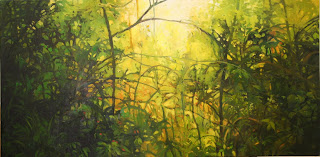...is what I find myself doing as I prepare my tenure file (due on September 21!). I decided to update the hoary teaching statement I've been carting around lo these many years, and have begun another, which I thought I'd publish here. All you students out there who know me well can tell me what I'm leaving out, or whether I've told lies...
I’ve taught, and the first thing I did when I taught art, was not to teach art.
Louise NevelsonI’ve only begun to learn what not to teach. I can teach a few of the eight hundred ways to hold a paintbrush, but I can’t teach a student to let her hand dance with the brush like Monet did, never approaching the canvas the same way twice. I can teach a student when to use poppy oil, and in what quantities, to make pigment approximate flesh, but I can’t teach him to how to paint a portrait as breath-takingly
present as those of Rembrandt. And so what I “teach” my students really amounts to this: to say “yes” with curiosity and vigor to all questions; to think originally and paint with integrity; to find, as they internalize the techniques and concepts associated with the craft of painting, their own way to art.
Saying “yes” should be easy, but it’s stunningly difficult for most students. To be smart is to be a critic, they think, and they scorn enthusiasm as a sign of naiveté. So enthusiasm (creating it, modeling it, sustaining it) guides my preparation for any course. Hard work that pays dividends can breed enthusiasm, as can surprise, and I find that these two strategies are the ones I use most often. Especially at the introductory level, I engage the former strategy by creating technically challenging assignments that build in complexity over the course of the semester, encouraging accomplishment through process. I know I’ve succeeded when I hear a student remark, on critique day, “I didn’t think I could do it,” to which I always reply: “I knew that you could.” Part of the responsibility for creating a challenging environment lies in maintaining defiant, perhaps quixotic, belief in potential. Whether that belief is justified or rewarded is somewhat beside the point. The latter strategy – surprise – requires that I design each class session in such a way that students can rarely take it for granted. So whether we’re taking an impromptu trip to the museum or drawing blindfolded to trip-hop, there should be a sense that we are all making discoveries together – that we are all (myself included) absolute beginners.
Chuck Close, an artist famous for his enormous portraits of fellow artists, once had occasion to tell Willem de Kooning that he’d painted more de Koonings than de Kooning. This is a useful anecdote for advanced undergraduate and graduate students who struggle (as they put it) to “find their style." It takes a mountain of self-knowledge (not to mention experience) to think originally, to feel comfortable in one’s own shoes. The work that students produce at this level is largely self-directed, and much of what I do amounts to giving permission, while also making frequent reference to historical and contemporary artists and painting practices that will feed students' process. Frequent group and individual critiques give students the opportunity to reflect on their work and establish a way of talking about it that enriches their own, and their viewers’, understanding.
Finally, I encourage all my students to separate the processes of thinking (which typically means overthinking) and painting. “Thinking” in painting should be
thinking through paint: that is to say, the process itself should be a particular kind of knowledge that is distinct from the processes of reflection, criticism, and contextualization (though these are quite necessary after the fact). Above all, I hope to teach my students that there is tremendous joy and deep satisfaction to be found in striving after art; the words I hear myself utter most often are:
just begin.









